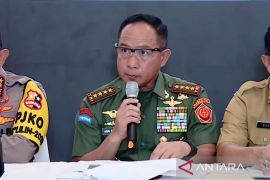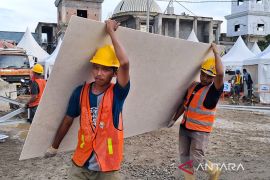The 1815 eruption of Tambora was one of the mightiest and deadliest ever recorded in history. On the Volcanic Explosivity Index (VEI), Tambora rates a 7, one of only four in the last ten thousand eruptions to do so. In comparison, the famous Mount Krakatoa blast was recorded at VEI 6, and Mt. St. Helens blast of May 1980 was VEI 5.
Tamboras catastrophic eruption began on April 5, 1815, with small tremors and pyroclastic flows. A shattering blast blew the mountain apart on the evening of April 10.
The blast, pyroclastic flows, and tsunamis that followed killed at least ten thousand islanders and destroyed the homes of 35 thousand more. Following the eruption, some eighty thousand people perished due to diseases and famine on Sumbawa Island, since crops could not grow. The eruption produced global climatic effects and directly and indirectly killed more than 100 thousand people.
In 1816, parts of the world as far off as Western Europe and Eastern North America experienced sporadic spells of heavy snow and killing frost through June, July, and August. Such cold weather events led to crop failures and starvation in those regions.
Before its eruption, Mount Tambora was about 4.3 thousand meters or about 14 thousand feet high. After the eruption ended, a caldera spanning some 6 kilometers or 3.7 miles across remained.
The volcano remains active, and smaller eruptions took place in 1880 and 1967. Episodes of increased seismic activity occurred in 2011, 2012, and 2013.
Currently, 2,851-meter-high Mount Tambora, which is located in Doro Ncanga, Dompu District, on Sumbawa Island, West Nusa Tenggara Province, Indonesia, is home to the Crested White-eye, Hill Mynas, Rainbow Lorikeets, flying foxes, deer, horses, wild pigs, and rainforest trees, among other things. Indonesia is the worlds second-largest mega biodiversity country, after Brazil.
The government has transformed the areas around Mount Tambora bearing the statuses of sanctuary, wildlife reserve, and hunting park into a national park.
The new national park covers a total area of 71,644 hectares, previously comprising a 23,840-hectare nature sanctuary, a 21,674-hectare wildlife reserve, and a 26,130-hectare hunting park.
Coinciding with the 200th commemoration of the eruption of Mount Tambora, President Joko "Jokowi" Widodo inaugurated Mount Tambora National Park during a special tourism promotion event called "Tambora Greets The World", on April 11, 2015.
The head of state emphasized the importance of Mount Tambora National Park, stating that it was an asset that must be preserved and developed to benefit the local people.
Joko Widodo ordered the local people to preserve and look after the region well to turn it into an ecotourism destination.
He also hoped that the Tambora Festival is organized as an annual event to bring more added value to national tourism.
"I wish this event is held every year to promote tourism in Bima and Dompu. The Tambora Festival must be held annually, with funding from the central government, so that all know where Dompu, Bima, and West Nusa Tenggara are, as well as where Indonesia is," he remarked.
Moreover, Tourism Minister Arief Yahya had earlier stated that the Mount Tambora ecotourism area can serve as the engine to drive tourism development in the region.
"I believe it can work in this manner, and that the Tambora Greet the World event has successfully attracted national and global attention. Hopefully, it will become an annual event," he noted.
He remarked that in the future, Lombok Island and West Nusa Tenggara would be among the chief tourist destinations in Indonesia, similar to Bali and other locations.
"This year, we believe one million people will visit West Nusa Tenggara," Yahya pointed out.
The minister expressed optimism that the Tambora National Park, with a vast savannah, could become an attractive ecotourism destination that could lure domestic and foreign tourists.
"The opportunities here are ecotourism and agrotourism. The accessibility and attractions are good, and now, it is only a matter of providing amenities," the minister affirmed.
To support the development of Mount Tambora National Park, the Environmental Affairs and Forestry Ministry will provide facilities and infrastructure, such as new roads, bridges, bird-watching stations, hiking trails, and hill climbing tracks.
The ministry is coordinating with the West Nusa Tenggara Natural Resources Conservation Agency (BKSDA) to improve public awareness regarding forest preservation, deer hunting, and nomadic farming methods.
Environmental Affairs and Forestry Minister Siti Nurbaya Bakar noted in a statement on April 12, 2015, that her ministry has learnt about rampant illegal logging activities in the newly established national park.
To protect the forest, the ministry has introduced a system of adopting trees, particularly endemic species such as Duobanga trees that could reach a height of up to 40 meters, with a diameter of 120 centimeters.
Following a suggestion by nature lovers, the ministry will also organize a cleanup campaign along Mount Tamboras hiking trails.
(f001/INE)
Reporter: Fardah
Editor: Fardah Assegaf
Copyright © ANTARA 2015











